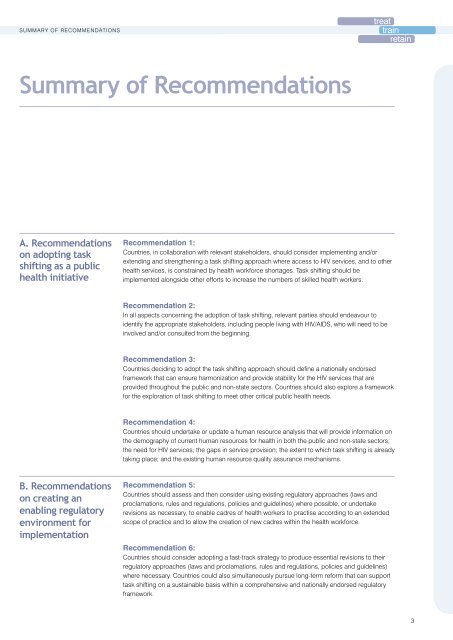Task Shifting - Global Recommendations and Guidelines - unaids
Task Shifting - Global Recommendations and Guidelines - unaids
Task Shifting - Global Recommendations and Guidelines - unaids
Create successful ePaper yourself
Turn your PDF publications into a flip-book with our unique Google optimized e-Paper software.
summary of recommendations<br />
Summary of <strong>Recommendations</strong><br />
A. <strong>Recommendations</strong><br />
on adopting task<br />
shifting as a public<br />
health initiative<br />
Recommendation 1:<br />
Countries, in collaboration with relevant stakeholders, should consider implementing <strong>and</strong>/or<br />
extending <strong>and</strong> strengthening a task shifting approach where access to HIV services, <strong>and</strong> to other<br />
health services, is constrained by health workforce shortages. <strong>Task</strong> shifting should be<br />
implemented alongside other efforts to increase the numbers of skilled health workers.<br />
Recommendation 2:<br />
In all aspects concerning the adoption of task shifting, relevant parties should endeavour to<br />
identify the appropriate stakeholders, including people living with HIV/AIDS, who will need to be<br />
involved <strong>and</strong>/or consulted from the beginning.<br />
Recommendation 3:<br />
Countries deciding to adopt the task shifting approach should define a nationally endorsed<br />
framework that can ensure harmonization <strong>and</strong> provide stability for the HIV services that are<br />
provided throughout the public <strong>and</strong> non-state sectors. Countries should also explore a framework<br />
for the exploration of task shifting to meet other critical public health needs.<br />
Recommendation 4:<br />
Countries should undertake or update a human resource analysis that will provide information on<br />
the demography of current human resources for health in both the public <strong>and</strong> non-state sectors;<br />
the need for HIV services; the gaps in service provision; the extent to which task shifting is already<br />
taking place; <strong>and</strong> the existing human resource quality assurance mechanisms.<br />
B. <strong>Recommendations</strong><br />
on creating an<br />
enabling regulatory<br />
environment for<br />
implementation<br />
Recommendation 5:<br />
Countries should assess <strong>and</strong> then consider using existing regulatory approaches (laws <strong>and</strong><br />
proclamations, rules <strong>and</strong> regulations, policies <strong>and</strong> guidelines) where possible, or undertake<br />
revisions as necessary, to enable cadres of health workers to practise according to an extended<br />
scope of practice <strong>and</strong> to allow the creation of new cadres within the health workforce.<br />
Recommendation 6:<br />
Countries should consider adopting a fast-track strategy to produce essential revisions to their<br />
regulatory approaches (laws <strong>and</strong> proclamations, rules <strong>and</strong> regulations, policies <strong>and</strong> guidelines)<br />
where necessary. Countries could also simultaneously pursue long-term reform that can support<br />
task shifting on a sustainable basis within a comprehensive <strong>and</strong> nationally endorsed regulatory<br />
framework.

















